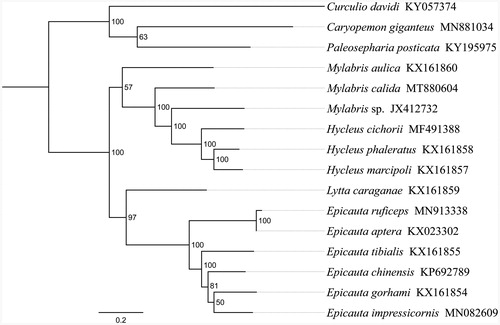Abstract
Beetle genus Mylabris (Meloidae) was described by Fabricius (1775) and had been well known due to its relevance to traditional medicine (e.g., cantharidin production). Here, we sequenced and annotated the mitochondrial genome (mitogenome) of Mylabris calida, one of species within Mylabris. This mitogenome was 15,149 bp long and encoded 13 protein-coding genes (PCGs), 22 transfer RNA genes (tRNAs) and two ribosomal RNA unit genes (rRNAs). All 13 PCGs were initiated by the ATN (ATG, ATT and ATA) codon. All PCGs terminated with the stop codon TAA or TAG except for cox1, cox2, nad5 and nad4 which end with the incomplete codon T—. Phylogenetic analysis showed that M. calida got together with the same genus species Mylabris sp., M. aulica and three Hycleus species (H. cichorii, H. phaleratus and H. marcipoli), indicating Mylabris has a closer relationship with Hycleus than other genera within Meloidae.
Meloidae, commonly known as blister beetles, is relatively well known in the production of cantharidin, parasitoid biology of its larval phases and biological literature due to its hypermetabolic larval development (Bologna et al. Citation2008). Mylabrini is the most speciose tribe of Meloidae, with approximately 750 described species being assigned to 11 genera (Pan and Bologna Citation2014).
Specimens of M. calida were collected from Yan’an City, Shaanxi Province, China (36°34′N, 109°41′E, May 2019) and were stored in Entomological Museum of Yan’an University (Accession number YAU-E-MC08). After morphological identification, total genomic DNA was extracted from tissues using DNeasy DNA Extraction kit (Qiagen). The mitogenome sequence of M. calida was generated using Illumina HiSeq 2500 Sequencing System. In total, 6.4 G raw reads were obtained, quality-trimmed, and assembled using MITObim v 1.7 (Hahn et al. Citation2013). By comparison with the homologous sequences of other Meloidae species from GenBank, the mitogenome of M. calida was annotated using software GENEIOUS R8 (Biomatters Ltd., Auckland, New Zealand).
The nearly complete mitogenome of M. calida is 15,149 bp (Genbank accession, MT880604). It contains 13 protein-coding genes (PCGs), 22 tRNA genes, two rRNA genes, and one partial non-coding AT-rich region. Gene order was conserved and identical to that of Drosophila yakuba and to most other previously sequenced Meloidae species (Du et al. Citation2016, Citation2017; Jie et al. Citation2016; Han et al. Citation2020). The overall base composition of the mitogenome was estimated to be A 37.5%, T 34.8%, C 16.9% and G 10.8%, with a high A + T content of 72.3%. All 13 PCGs of M. calida have the conventional ATN start codons for invertebrate mitochondrial PCGs (seven ATT, five ATG and one ATA). Most of the PCGs terminate with the stop codon TAA or TAG, whereas cox1, cox2, nad5 and nad4 end with the incomplete codon T. The 22 tRNA genes vary from 59 bp (trnS1) to 71 bp (trnK). Two rRNA genes (rrnL and rrnS) locate at trnL1/trnV and trnV/control region, respectively. The lengths of rrnL and rrnS in M. calida are 1,278 and 767 bp, with the AT contents of 76.1% and 74.1%, respectively.
Phylogenetic analysis was performed based on the nucleotide sequences of 13 PCGs from 16 Coleoptera species. Phylogenetic tree was constructed through raxmlGUI 1.5 (Silvestro and Michalak Citation2012). Results showed that the new sequenced species M. calida got together with the same genus species Mylabris sp., M. aulica and three Hycleus species (H. cichorii, H. phaleratus and H. marcipoli), indicating Mylabris has a closer relationship with Hycleus than other genera within Meloidae (). In conclusion, the mitogenome of M. calida is sequenced in this study and can provide essential DNA molecular data for further phylogenetic and evolutionary analysis of Meloidae.
Disclosure statement
No potential conflict of interest was reported by the author(s).
Data availability statement
The data that support the findings of this study are openly available in NCBI (National Center for Biotechnology Information) at https://www.ncbi.nlm.nih.gov/, reference number MT880604.
Additional information
Funding
References
- Bologna MA, Oliverio M, Pitzalis M, Mariottini P. 2008. Phylogeny and evolutionary history of the blister beetles (Coleoptera, Meloidae). Mol Phylogenet Evol. 48(2):679–693.
- Du C, He S, Song X, Liao Q, Zhang X, Yue B. 2016. The complete mitochondrial genome of Epicauta chinensis (Coleoptera: Meloidae) and phylogenetic analysis among Coleopteran insects. Gene. 578(2):274–280.
- Du C, Zhang L, Lu T, Ma J, Zeng C, Yue B, Zhang X. 2017. Mitochondrial genomes of blister beetles (Coleoptera, Meloidae) and two large intergenic spacers in Hycleus genera. BMC Genomics. 18(1):698–698.
- Hahn C, Bachmann L, Chevreux B. 2013. Reconstructing mitochondrial genomes directly from genomic next-generation sequencing reads—a baiting and iterative mapping approach. Nucleic Acids Res. 41(13):e129–e129.
- Han X, Li Y, Lu C, Liang G, Zhang F. 2020. The complete mitochondrial genome of Epicauta ruficeps (Coleoptera: Meloidae). Mitochondrial DNA B. 5(3):2049–2050.
- Jie H, Lei M, Li P, Feng X, Zeng D, Zhao G, Zhu J, Zhang C, Yu M, Huang Y, et al. 2016. The complete nucleotide sequence of the mitochondrial genome of Epicauta aptera Kaszab. Mitochondrial DNA B. 1(1):489–490.
- Pan Z, Bologna MA. 2014. Taxonomy, bionomics and faunistics of the nominate subgenus of Mylabris fabricius, 1775, with the description of five new species (Coleoptera: Meloidae: Mylabrini). Zootaxa. 3806(1):1–3.
- Silvestro D, Michalak I. 2012. RaxmlGUI: a graphical front-end for RAxML. Org Divers Evol. 12(4):335–337.

